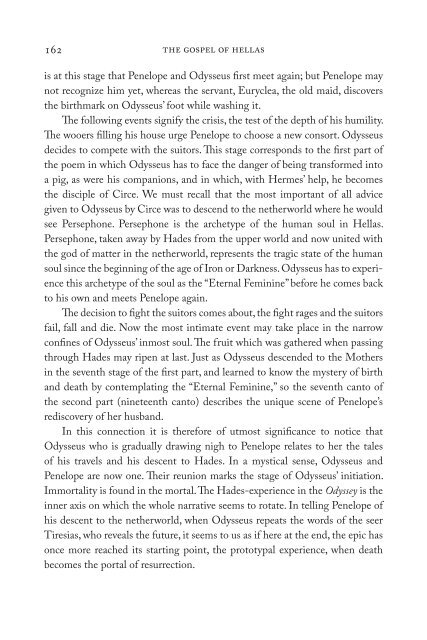The Gospel of Hellas - Research Institute for Waldorf Education
The Gospel of Hellas - Research Institute for Waldorf Education
The Gospel of Hellas - Research Institute for Waldorf Education
Create successful ePaper yourself
Turn your PDF publications into a flip-book with our unique Google optimized e-Paper software.
the gospel <strong>of</strong> hellas<br />
is at this stage that Penelope and Odysseus first meet again; but Penelope may<br />
not recognize him yet, whereas the servant, Euryclea, the old maid, discovers<br />
the birthmark on Odysseus’ foot while washing it.<br />
<strong>The</strong> following events signify the crisis, the test <strong>of</strong> the depth <strong>of</strong> his humility.<br />
<strong>The</strong> wooers filling his house urge Penelope to choose a new consort. Odysseus<br />
decides to compete with the suitors. This stage corresponds to the first part <strong>of</strong><br />
the poem in which Odysseus has to face the danger <strong>of</strong> being trans<strong>for</strong>med into<br />
a pig, as were his companions, and in which, with Hermes’ help, he becomes<br />
the disciple <strong>of</strong> Circe. We must recall that the most important <strong>of</strong> all advice<br />
given to Odysseus by Circe was to descend to the netherworld where he would<br />
see Persephone. Persephone is the archetype <strong>of</strong> the human soul in <strong>Hellas</strong>.<br />
Persephone, taken away by Hades from the upper world and now united with<br />
the god <strong>of</strong> matter in the netherworld, represents the tragic state <strong>of</strong> the human<br />
soul since the beginning <strong>of</strong> the age <strong>of</strong> Iron or Darkness. Odysseus has to experience<br />
this archetype <strong>of</strong> the soul as the “Eternal Feminine” be<strong>for</strong>e he comes back<br />
to his own and meets Penelope again.<br />
<strong>The</strong> decision to fight the suitors comes about, the fight rages and the suitors<br />
fail, fall and die. Now the most intimate event may take place in the narrow<br />
confines <strong>of</strong> Odysseus’ inmost soul. <strong>The</strong> fruit which was gathered when passing<br />
through Hades may ripen at last. Just as Odysseus descended to the Mothers<br />
in the seventh stage <strong>of</strong> the first part, and learned to know the mystery <strong>of</strong> birth<br />
and death by contemplating the “Eternal Feminine,” so the seventh canto <strong>of</strong><br />
the second part (nineteenth canto) describes the unique scene <strong>of</strong> Penelope’s<br />
rediscovery <strong>of</strong> her husband.<br />
In this connection it is there<strong>for</strong>e <strong>of</strong> utmost significance to notice that<br />
Odysseus who is gradually drawing nigh to Penelope relates to her the tales<br />
<strong>of</strong> his travels and his descent to Hades. In a mystical sense, Odysseus and<br />
Penelope are now one. <strong>The</strong>ir reunion marks the stage <strong>of</strong> Odysseus’ initiation.<br />
Immortality is found in the mortal. <strong>The</strong> Hades-experience in the Odyssey is the<br />
inner axis on which the whole narrative seems to rotate. In telling Penelope <strong>of</strong><br />
his descent to the netherworld, when Odysseus repeats the words <strong>of</strong> the seer<br />
Tiresias, who reveals the future, it seems to us as if here at the end, the epic has<br />
once more reached its starting point, the prototypal experience, when death<br />
becomes the portal <strong>of</strong> resurrection.

















